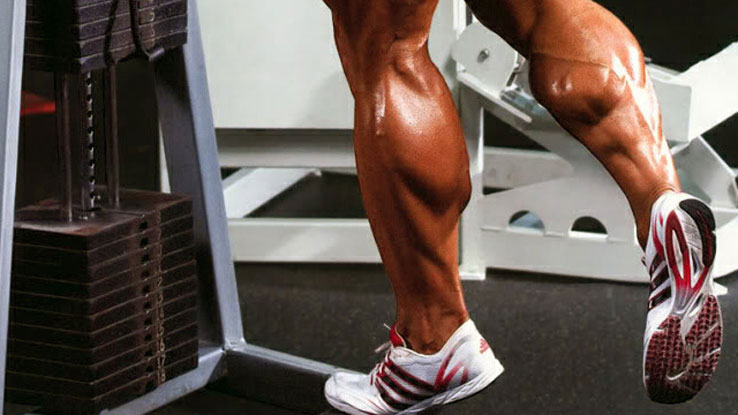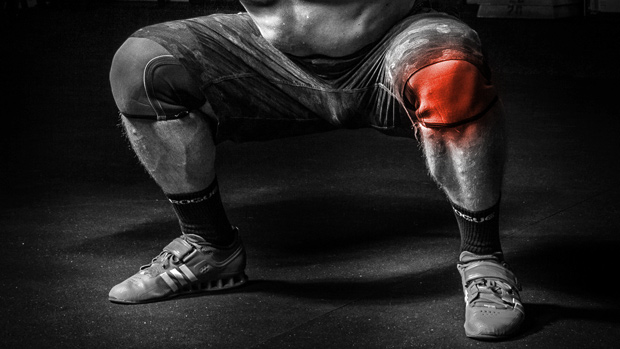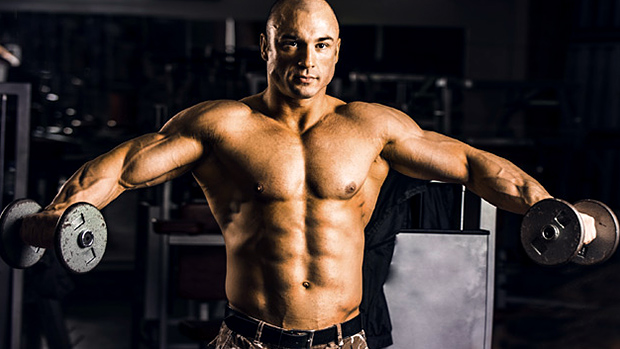In my small home gym, I have three dedicated machines for calf training: a standing calf raise unit that goes up to 600 pounds, a seated calf raise machine, and a step platform equipped with a handle for one-leg calf raises.
These are the sort of machines that you'd see in large commercial gym, not usually in a smaller home-based setup. So why do I have them in mine? Simple – my calves suck, and I need all the artillery I can get my hands, or in this case, feet on!
After years of hard work using all kinds of popular calf training techniques – drop sets, negative-accentuated training, explosive movements, extended sets, burns, supersets, tri-sets and giant sets, escalating density training, tempo manipulation, plyometrics, unilateral training, you name it – I'm embarrassed to say the gains have been minimal.
The Dancers' Answer?

My daughters are competitive dancers and they compete a few times a year. Dancers tend to have aesthetic physiques. They're in great shape. Most bodybuilders, however, would consider them a bit "small" for their liking. However, dancers sport some serious calves, often times blowing away that of the typical much larger gym rat.
Success tends to leave clues. If you want to build a nice set of arms and shoulders, train like a gymnast. For glutes and hamstrings, train like a sprinter. For calves, bodybuilders can learn quite a bit from dancers.
The dancer's secret for well-developed calves is simply that they're constantly on their toes. It's basically repetition after repetition of bodyweight calf raises (a position referred to as relevé in ballet) performed on a daily basis. After a while it becomes almost effortless for them, resulting in comparatively monstrous calves. While ditching the weight belt for a tutu likely isn't in the cards for most, I discovered that there is a way to experience a similar calf hypertrophy effect.
I decided to perform 100 reps of bodyweight calf raises every day. As simple as that sounds, I did this every day for a month and was blown away by the results in my stubborn toothpicks.
Calf 101
To understand how this can produce such radical growth in even the most stubborn set of pigeon-legs requires an understanding of the calves' unique characteristics.
The calves consist of many muscles, but the two primary workhorses bodybuilders are concerned with are the gastrocnemius and the soleus. The gastrocnemius receives more stimulation with the knees extended (standing calf raise) and the soleus with the knees bent (seated calf raise). That said, the soleus still receives some stimulation during a calf raise even when the knees are extended.
The soleus has a greater slow-twitch (ST) muscle fiber makeup – up to 88%, one of the highest ST compositions in the human body – and thus, higher reps should be performed. Most traditional calf training routines, however, fail to generate enough volume for this "endurance" muscle.
This is a shame, as a significant amount of volume at a decent intensity can result in hypertrophy. Lifting a substantial load, like your entire bodyweight, every day for a high number of reps will definitely put on muscle.
Since you're not using huge loads, this training can be accomplished daily, and it's the frequency that coaxes your body to adapt quickly. You'll be sore at first, but it won't be that bad.
Even though you may be used to much higher forces from a regular assault of barbell jumps (the acceleration end of the force equation) and heavy standing calf raises (the mass end of the force equation), this is a novel stimulus that can induce some real soreness along with some impressive results.

Change of Range
Not only are the intensity, volume, and frequency different from what's normally prescribed for calves, the range is also different. We've always been told to perform a full range of motion when training calves; in fact, many experts advocate emphasizing the stretched position.
For someone who has difficulty performing a full squat, this is very good advice. If you automatically lean forward and/or your heels raise when you squat, you need to stretch those calves out.
But what if you're one of those guys that can full squat no problem with an upright trunk – your knees can easily pass your toes with your heels flat on the ground? Doing some partial calf training (i.e., emphasizing the top, contracted position) may be exactly what the doctor ordered!
The Recipe
Start with 50 reps of heel raises and work up to 100 reps with just bodyweight. Do that every day without fail for a month. You'll be amazed at the growth and definition that you'll acquire, and as a bonus, improved balance and coordination skills.
Actually, you can consider this as a form of prehabilitation for your ankles, which is particularly useful if you play any recreational sport and/or are plagued with constant ankle sprains.
As simple as it sounds, proper form is very important. Situate your feet about shoulder-width apart and toes turned slightly out. Concentrate on raising the heels straight up as if they're puppet strings being pulled up by God himself.
Make sure to contract hard at the top – think of a double biceps pose, except you're squeezing the hell out of your calves. Don't hold on to a wall or machine for support. The idea is not to deload in any manner, as we want those small stabilizers to grow as well. Simply keep your arms at your sides or your hands on your hips.
You must be in bare feet (no shoes). Make sure to raise the heels as high as possible, and distribute your weight evenly over all your toes. Hold the top, contracted position for a full 2 seconds. It must be a definite stop at the top, and you must feel a peak contraction in the calves.
Next, control the lowering – don't just drop like a bomb! If you fail to perform these two steps properly, the rep doesn't count. It's that simple. They must be quality repetitions to optimally benefit from this type of training. The prime movers will get hit, but so will all those little stabilizers, and in the long run, it will make a big difference in the overall growth of your calves.
You'll need to invest up to 10 minutes a day for a month to reap the benefits of this method. Consider that each controlled repetition should take 6 seconds (i.e., 2 seconds up, 2 seconds at the top, 2 seconds down, and no pause at the bottom) and you're performing up to 100 reps per day – that equals 10 minutes.
Results?
You can easily put an inch on your calves in one month with this method. However, you must be consistent. Every day means every damn day. I suggest getting into a routine. Pick a time of the day that you can perform this and stick to it. Do it in the morning while you cook breakfast, or on your coffee break, or at night while you re-watch episodes of Storage Wars, much to the chagrin of your long-suffering family.

If you're understandably skeptical if this type of high volume bodyweight training will do anything for muscle size, try performing 100 reps of chin-ups or dips every day for a month and see what happens. My T Nation colleague Chad Waterbury – a guy who knows a thing or two about hypertrophy – has written about this concept in the past and believe me, it works!
Remember, it doesn't take any equipment to do. Literally, nothing is required – no machines, no shoes, nothing, just a bit of effort.
Once you've gone through a full month, throw on an additional 10 or 20 pounds using a weighted vest and go at it again. (Some guys will need to do this sooner if they find it easy after a couple of weeks.)
Keep building until you reach a level of development you're satisfied with, whereupon you can maintain your newfound growth with 2-3 sessions a week. Even just one session a week will do the trick if you return to machine work for your calves, which you'll likely welcome to break up the mental and physical monotony.
It's amazing how I'd gone about the war on my calves all wrong! Instead of more weapons in my arsenal, I actually needed fewer. All these fancy calf machines like the ones taking up space in my basement really aren't necessary; heck, I found you don't even need shoes!
What you do need, however, is a bit of time, patience, and lactate tolerance, and you can transform those young, immature, and disproportional calves into some massive full-grown cows that are on par with your other body parts.




